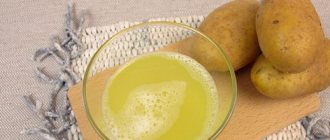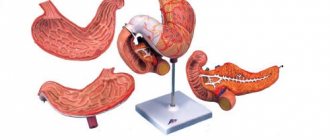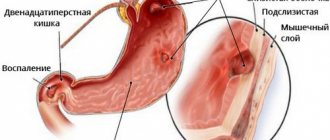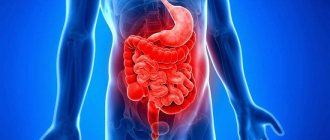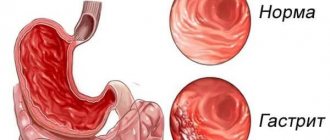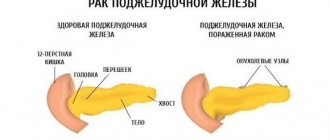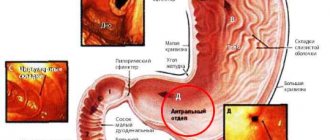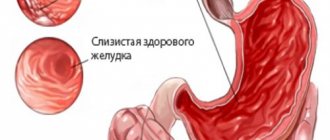Full text of the article:
Damage to the gastric mucosa is associated with damage and regeneration of epithelial cells.
The term "gastritis" is used to refer to inflammation associated with damage to the mucosa. However, damage and regeneration of epithelial cells is not always accompanied by inflammation of the mucosa. This difference causes significant confusion because The term gastritis is more often used to describe changes in the gastric mucosa identified by endoscopic and radiological findings rather than specific histological findings. Damage and regeneration of the epithelium without concomitant inflammation should be classified as gastropathy. The causes, natural history and clinical significance of gastropathy differ from gastritis. Gastropathy is usually caused by irritating agents such as drugs (NSAIDs and alcohol), bile reflux, hypovolemia, and chronic heart failure. Gastritis is usually caused by infectious agents (like HP), allergic reactions and hypersensitivity reactions. This article discusses the classification and diagnosis of gastritis and gastropathy. The causes of acute and chronic gastritis are presented separately.
Acute gastritis
Acute gastritis is an acute inflammation of the gastric mucosa that occurs when exposed to poor quality food or the use of certain medications. Acute gastritis, in turn, is divided into catarrhal, fibrinous, corrosive and phlegmonous.
- Catarrhal gastritis is an acute inflammation of the gastric mucosa after a single intake of poor quality food, systematic poor nutrition, and severe stress.
- Fibrinous gastritis (diphtheritic) is an acute gastritis that is characterized by diphtheritic inflammation of the gastric mucosa. Occurs in severe infectious diseases, poisoning with sublimate, acids.
- Corrosive gastritis (necrotic gastritis) is an acute gastritis with necrotic tissue changes that develops when concentrated acids or alkalis enter the stomach.
- Phlegmonous gastritis is acute gastritis with purulent inflammation of the stomach wall. Occurs during injuries, as a complication of gastric ulcer.
CLASSIFICATION OF GASTRITIS AND GASTROPATHIES
Several classifications of gastritis and gastropathy (such as the Sydney system) have been proposed. However, the classifications remain controversial due to gaps in knowledge of etiology and pathogenesis, differences in nomenclature, and the simultaneous presence of more than one type of gastritis and gastropathy in one patient. Thus, comparisons between studies using different nomenclature can be difficult. Most classifications distinguish between acute (short-term) and chronic (long-term) disease. The terms acute and chronic can also be used to describe the type of inflammatory infiltration. Acute inflammation is usually associated with nontrophilic infiltration; chronic inflammation is characterized by mononuclear cells, mainly lymphocytes, plasma cells and macrophages.
Chronic gastritis
Chronic gastritis is a long-term inflammatory lesion of the gastric mucosa, occurring with its structural restructuring and disruption of the secretory (acid- and pepsin-forming), motor and endocrine (synthesis of gastrointestinal hormones) functions of the stomach.
Classification depending on the cause:
- Helicobacter pylori gastritis (gastritis in which Helicobacter pylori is found in the body, a spiral-shaped bacterium that infects various parts of the stomach and duodenum). With this type of gastritis, the entrance section of the stomach (antrum, see figure) is usually affected.
- Autoimmune gastritis of the body of the stomach
- Chronic reflux gastritis
- Radiation, infectious gastritis, etc. (not related to Helicobacterрylorі)
Classification of gastritis based on types of secretion
- Gastritis with increased secretion
- Gastritis with normal secretion
- Gastritis with secretory insufficiency
According to localization, gastritis is divided into
- Antral (gastritis of the pyloric or outlet region, see figure)
- Fundal (gastritis of the fundus of the stomach)
- Pangastritis (common gastritis of the stomach)
When you experience the first complaints, pain and/or feeling of heaviness, bloating in the abdomen, belching, sour heartburn, or feeling unwell, you should immediately consult a doctor, because gastritis can be complicated by peptic ulcers and even stomach cancer.
First of all, the doctor finds out the nature of the complaints, their duration, the nature of the diet, and the presence of stressful situations.
In order to make a morphological diagnosis of gastritis, as well as to establish whether it is associated with Helicobacter pylori, it is necessary to conduct a number of diagnostic studies, such as: endoscopic examination, ph-metry (can be performed during an endoscopic examination or as a separate procedure), urease test for Helicobacter pylori, PCR of the gastric and duodenal mucosa, blood ELISA to determine antibodies to Helicobacter pylori.
The most important method in diagnosing gastritis is endoscopic examination , in which a special probe (endoscope) equipped with a video camera is inserted into the stomach and duodenum, with which the stomach and duodenum are examined. From the most changed areas during endoscopy, a biopsy (a piece of tissue) is taken for histological examination (a method that examines the structure of the tissue to exclude cancers and precancerous diseases of the stomach). It is also possible to perform ph-metry (measuring the acidity of the stomach contents) during endoscopy. It is the endoscopic method that determines the morphology of the mucosa, the degree of its damage, the depth of the damage and the localization of the pathological process.
breath test for Helicobacter pylori is also widely used . Helicobacterрylorі in the process of life produces urease (a special enzyme that accelerates the processing of urea into ammonia and carbon dioxide). This method, using a special device, allows you to compare the levels of gas composition in the original, normal version and with high urease activity.
To determine whether an organism is infected with Helicobacter рylorі, you can use the PCR diagnostic (polymerase chain reaction) - determining sections of Helicobacter рylorі DNA in a biopsy sample of the mucous membrane of the stomach and duodenum. As well as ELISA diagnostics - an enzyme-linked immunosorbent test that is used to determine the presence in the blood of antibodies IgA, IgM and IgG (immunoglobulins) to Helicobacter pylori. IgA and IgM indicate early infection (appear a few days after infection), and IgG indicate late infection (appear a month after infection).
Diagnosis of autoimmune gastritis includes the detection of antibodies to pariatal cells of the stomach, carried out by ELISA diagnostics.
BIOPSY
Accurate histological assessment of gastritis and gastropathy depends on optimizing the number and location of biopsies. Biopsies from areas of visible changes should be taken and sent for histological examination along with normal-appearing mucosa adjacent to the affected area (in separate containers). Angle biopsy is also useful because This is the approximate transition zone between the corpus and the antrum, where intestinal metaplasia and atrophy are most often found in environmental metaplastic atrophic gastritis. A duodenal biopsy may also be useful in diagnosing some forms of chronic gastritis. As an example, a biopsy from the duodenum can show signs of Crohn's disease in patients with granulomatous gastritis and celiac disease in patients with lymphocytic gastritis.
Treatment of acute gastritis
To cleanse the stomach, give the patient 2-3 glasses of water and induce vomiting. In case of chemical poisoning, gastric lavage is carried out using a thick gastric tube. Washing is carried out until the wash water is clean. During the first two days, no food is taken and a water-tea diet is prescribed. Then the diet is expanded, including slimy soups and cereals, jelly, white flour crackers, and soft-boiled eggs.
To eliminate pain, antispasmodics (for example, no-spa) and antacids (for example, Gaviscon, Rennie) are used; enterosorbents are recommended; prokinetics are prescribed for vomiting. For acute toxicoinfectious gastritis, antibiotics are needed.
Classification of gastritis and gastropathy
| Spicy |
|
| Regular forms |
|
| Unusual shapes |
|
Treatment of chronic gastritis
In the treatment of gastritis, much attention should be paid to lifestyle changes, try to avoid stress, follow a daily routine, get rid of bad habits (smoking, drinking alcohol), and of course follow dietary recommendations:
- For patients with gastritis, it is necessary to exclude fried foods, rich meat and fish broths, do not overeat, eat 5 - 6 times a day
- Do not consume foods that contribute to heartburn: strong tea, coffee, chocolate, carbonated drinks, alcohol, onion, garlic, butter
- Consume boiled meat, boiled fish, steamed food, pureed cereal soups (rolled oats, rice)
- Eat less cabbage, legumes, milk - foods that promote flatulence
Treatment of chronic gastritis with medications
- When stomach acidity is increased -
If a patient has gastritis with increased secretory activity, therapy for gastritis includes drugs that reduce gastric acidity, the so-called proton pump inhibitors.
They share five generations
- Omeprazole (Omez)
- Lansoprazole (Lanzap),
- Pantoprazole (Nolpaza, Zypantol)
- Rabeprazole (Pariet)
- Esomeprazole (Nexium)
As well as antacid drugs (Gaviscon, Rennie, Almagel, Maalox). It is preferable to use preparations containing carbonates and not containing aluminum (Gaviscon, Rennie).
Antacids are first aid drugs if a patient has heartburn; if it is difficult to see a doctor at the moment, the patient can take an antacid on his own.
Physiotherapy
For gastritis with increased secretion, it is recommended to use amplipulse therapy and a microwave electromagnetic field. Physiotherapy is carried out only during remission.
Treatment with folk remedies
For gastritis with increased secretion, it is recommended to drink herbal decoctions that have an enveloping, protective effect. Such herbal remedies include flax seeds, burdock root, coltsfoot leaves, calendula flowers, chamomile flowers. Medicinal raw materials are infused, take 2 tbsp. l. 4 times a day 10-15 minutes before meals.
From mineral waters, you can use low-mineralized alkaline waters: Borjomi, Slavyanskaya, Smirnovskaya. It should be consumed warm (the water is heated to remove excess carbon dioxide, which stimulates the secretion of gastric juice), degassed in ¾ cup 3 times a day an hour before meals.
- When stomach acidity is reduced -
For gastritis with reduced secretion, the gastroprotective drug Bismuth tripotassium citrate (De-nol) is used. Replacement therapy is also indicated: gastric juice, pepsidil, acidin pepsin, bitterness (tincture of dandelion root, tincture of wormwood herb).
Physiotherapy
Galvanization, electrophoresis of calcium and chlorine enhances the secretion of gastric juice.
Treatment with folk remedies
To increase the acidity of gastric juice, use: cabbage juice, apple juice, or grated apple, as well as grated pumpkin and raw potato juice. The goal of herbal medicine for gastritis with low acidity is to stimulate the secretion of gastric juice and also relieve inflammation.
The following medicinal plants are used: rhizomes of calamus, calendula flowers, chamomile flowers, yarrow herb, dandelion flowers, large plantain leaves. The herbs must be crushed, dosed (1 teaspoon of each herb), mixed, and the medicine prepared. Pour a tablespoon of the mixture into a glass of boiling water, heat in a water bath for 15 minutes, leave until it cools (about 45 minutes), add boiled water to the initial volume, take 2 tbsp. l. 4 times a day
You can also use tincture of wormwood herb, 15-20 drops 20 minutes before meals. This bitter tincture will stimulate the secretory function of the stomach.
For gastritis with low acidity, mineral waters are also used for treatment. In this case, there is no need to heat the water. You need to drink water slowly ¾ glass 20 minutes before meals. It is best to use “Essentuki-4”, “Essentuki-17”.
Manifestations of the disease at diagnosis
With a clear understanding and definition of gastritis, it is still impossible to make a diagnosis based on symptoms alone. More research is needed. Naturally, gastritis can only be determined after poisoning with chemicals, without even conducting in-depth diagnostics; in other cases, vomiting and chills may indicate the presence of other problems in the body.
Patient examinations are primarily aimed at excluding other pathologies, for example, pancreatitis or liver failure, even these diseases have similar symptoms to gastritis. In addition, it is also not possible to determine only by external signs whether a patient has gastritis or a peptic ulcer.
Treatment of Helicobacter pylori chronic gastritis
If tests are positive for Helicobacter pylori, a weekly triple treatment regimen, or “quadruple therapy,” is prescribed. Treatment regimens are selected for each patient by the attending physician.
A triple weekly treatment regimen includes the use of a combination of antibiotics sensitive to Helicobacter pylori, as well as proton pump inhibitors. Quadruple therapy - antibiotics, antibacterial agents, proton pump inhibitors, gastroprotectors.
After a month or two, it is necessary to take a repeat test for Helicobacter pylori, and if the result is positive, decide on the issue of repeated anti-Helicobacter therapy, taking into account the patient’s complaints.
Diagnosis of pangastritis
The optimal examination method is endoscopy. In addition to it, you can use an X-ray examination of the stomach, a biochemical blood test, a general blood test, a stool test, an ultrasound of the abdominal organs to exclude other diseases of the liver, pancreas, gall bladder, and colonoscopy to determine intestinal diseases.
Changes in the gastric mucosa determine the degree and activity of inflammation, the presence of atrophy (“depletion” of the gastric glands), and the presence of degenerated mucosa (metaplasia). In addition, the endoscopist can in his conclusion describe the signs of hemorrhagic (i.e. with hemorrhages), erosive (erosions), ulcerative, hyperplastic (i.e. with thickened folds in the stomach), associated with bile reflux (reflux from the duodenum). intestines) gastritis.
Thus, when forming a diagnosis, the following categories will be taken into account: localization of inflammation, causative factor, changes during microscopic examination and what the specialist saw during gastroscopy (EGD). This means that before the doctor’s verdict, the patient must undergo an esophagogastroduodenoscopy with a biopsy, a general blood test, a stool test to determine helminthic infestation and the characteristics of food digestion, pH-metry to determine the amount and concentration of secreted acid, tests to determine H. pylori, a biochemical blood test , possibly tests to identify parasitic diseases (giardia, amoebas). Additionally, X-ray examinations of the stomach and intestines may be prescribed.
Страсть, ласку и свое красивое тело, шлюхи Сочи по вызову с yesssochi.ru готовы на многое, ради вашего удовольствия. Вы можете воспользоваться услугами проститутки тогда, когда этого пожелаете, достаточно сделать один звонок и договориться о встрече. Красивые шлюхи Сочи по вызову, сочные и сладкие, они такие весёлые и стройные, что у тебя будет сегодня классный секс. Твои мечты и желания реализуются.
